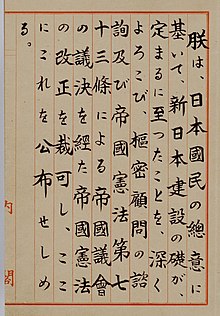
Back دستور اليابان Arabic জাপানৰ সংবিধান Assamese Yaponiya konstitusiyası Azerbaijani Канстытуцыя Японіі Byelorussian Японой Үндэһэн Хуули BXR Constitució del Japó Catalan دەستووری ژاپۆن CKB Verfassung des Staates Japan German Σύνταγμα της Ιαπωνίας Greek Konstitucio de Japanio Esperanto
| Constitution of Japan | |
|---|---|
 Preamble of the Constitution | |
| Overview | |
| Original title | 日本国憲法 |
| Jurisdiction | Japan |
| Presented | 3 November 1946 |
| Date effective | 3 May 1947 |
| System | Unitary parliamentary constitutional monarchy[1] |
| Government structure | |
| Branches | Three |
| Head of state | Not defined in constitution.[2] The Emperor is "the symbol of the State and of the unity of the people", but carries many functions of a head of state.[1] |
| Chambers | Bicameral (National Diet: House of Representatives, House of Councillors) |
| Executive | Cabinet, led by a Prime Minister |
| Judiciary | Supreme Court |
| Federalism | Unitary |
| Electoral college | No |
| History | |
| First legislature | |
| First executive | 24 May 1947 |
| First court | 4 August 1947 |
| Amendments | 0[3] |
| Location | National Archives of Japan |
| Author(s) | Allied GHQ and members of the Imperial Diet |
| Signatories | Emperor Shōwa |
| Supersedes | Meiji Constitution |
| Full text | |
| This article is part of a series on |
| Politics of Japan |
|---|
 |
|
|
The Constitution of Japan (Shinjitai: 日本国憲法, Kyūjitai: 日本國憲󠄁法, Hepburn: Nihon-koku kenpō) is the constitution of Japan and the supreme law in the state. It was written primarily by American civilian officials working under the Allied occupation of Japan after World War II. The current Japanese constitution was promulgated as an amendment of the Meiji Constitution of 1890 on 3 November 1946 when it came into effect on 3 May 1947.[4]
The constitution provides for a parliamentary system of government and guarantees certain fundamental human rights. In contrast to the Meiji Constitution, which invested the Emperor of Japan with supreme political power, under the new constitution the Emperor was reduced to "the symbol of the State and of the unity of the people" and exercises only a ceremonial role acting under the sovereignty of the people for constitutional monarchy.[5]
The constitution, also known as the MacArthur Constitution,[6][7] "Post-war Constitution" (戦後憲法, Sengo-Kenpō), or the "Peace Constitution" (平和憲法, Heiwa-Kenpō),[8] was drafted under the supervision of U.S. General Douglas MacArthur, the Supreme Commander for the Allied Powers, during the Allied occupation of Japan after World War II.[9] Japanese scholars reviewed and modified it before adoption.[10] It changed Japan's previous system of semi-constitutional monarchy and stratocracy with a parliamentary monarchy. The Constitution is best known for Article 9, by which Japan renounces its right to wage war and maintain military forces.[11] Despite this, Japan retains de facto military capabilities in the form of the Self-Defense Forces and also hosts a substantial American military presence.
The Japanese constitution is the oldest unamended constitution in the world. It has not had any amendments to its text in more than 70 years. At roughly 5,000 words, it is a relatively short constitution; the average national constitution has about 21,000 words.[3][12]
- ^ a b Kristof, Nicholas D. (12 November 1995). "THE WORLD;Japan's State Symbols: Now You See Them ..." The New York Times. Retrieved 5 October 2019.
- ^ Kakinohana, Hōjun (23 September 2013). "個人の尊厳は憲法の基 ― 天皇の元首化は時代に逆行 ―". Japan Institute of Constitutional Law (in Japanese). Archived from the original on 25 October 2019. Retrieved 25 October 2019.
- ^ a b "The Anomalous Life of the Japanese Constitution". Nippon.com. 15 August 2017. Archived from the original on 11 August 2019. Retrieved 11 August 2019.
- ^ Goes into Effect, New Japanese Constitution. "May 3, 1947, New Japanese Constitution goes into effect". www.history.com. History.com Editors. Retrieved 4 May 2022.
- ^ Takemae 2002, pp. 270–271.
- ^ Kawai, Kazuo (1958). "The Divinity of the Japanese Emperor". Political Science. 10 (2): 3–14. doi:10.1177/003231875801000201.
- ^ "The American Occupation of Japan, 1945-1952 | Asia for Educators | Columbia University".
- ^ Kapur 2018, p. 11.
- ^ Moritsugu, Ken (18 August 2016). "Biden's remark on Japan Constitution raises eyebrows". AP NEWS. Retrieved 10 August 2019.
- ^ Kapur 2018, p. 9.
- ^ Ito, Masami, "Constitution again faces calls for revision to meet reality Archived 8 November 2019 at the Wayback Machine", Japan Times, 1 May 2012, p. 3.